Are you curious about all of the red fruits throughout the world? Check out this comprehensive list of the 40 red fruits from around the globe and learn about their distinct tastes and health benefits. Let’s dive in!
1. Red Apple
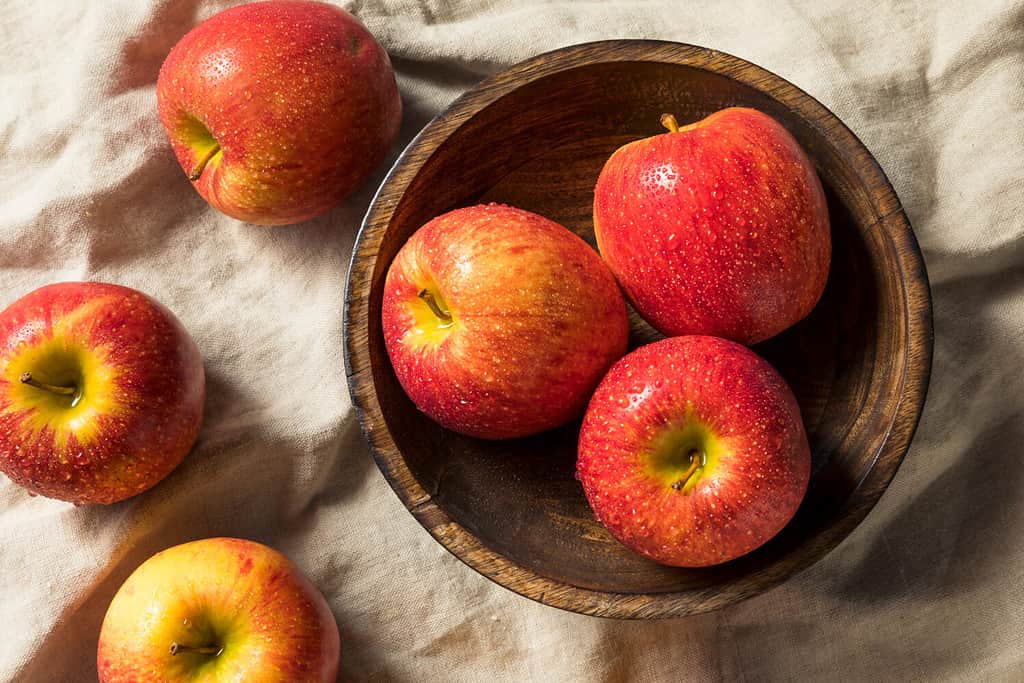
Red apples are some of the most popular red fruits across the globe
©Brent Hofacker/Shutterstock.com
As one of the most popular fruits on the planet, apples come in many colors. There are over 20 different red varieties of apple, including Red Delicious, Royal Gala, and Fuji. Some are super sweet and crisp, while others are more mild with tough skin. Red apples are rich in fiber and antioxidants, which can lower your risk of heart disease, diabetes, and other conditions.
2. Strawberry
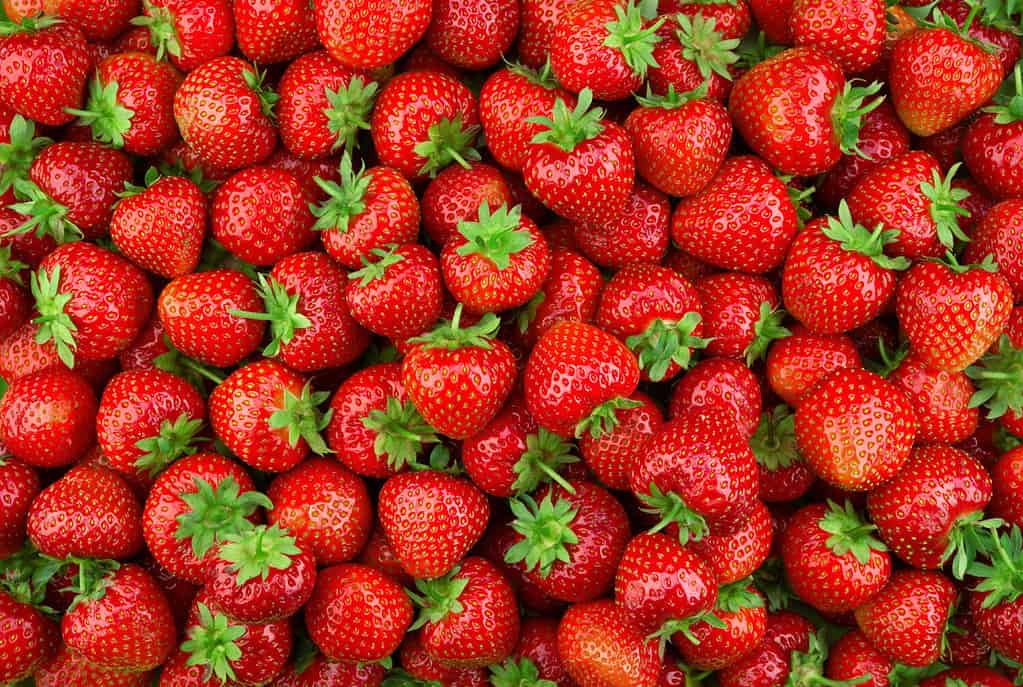
Strawberries are low in calories and support heart health
©MarcoFood/Shutterstock.com
Cultivated worldwide, strawberries are one of the most famous fruits on the planet. And they’re great for you, too! They are low in calories and support heart health, help to lower blood pressure, and can regulate blood sugar. Strawberries are fragrant, very sweet, and juicy.
3. Watermelon
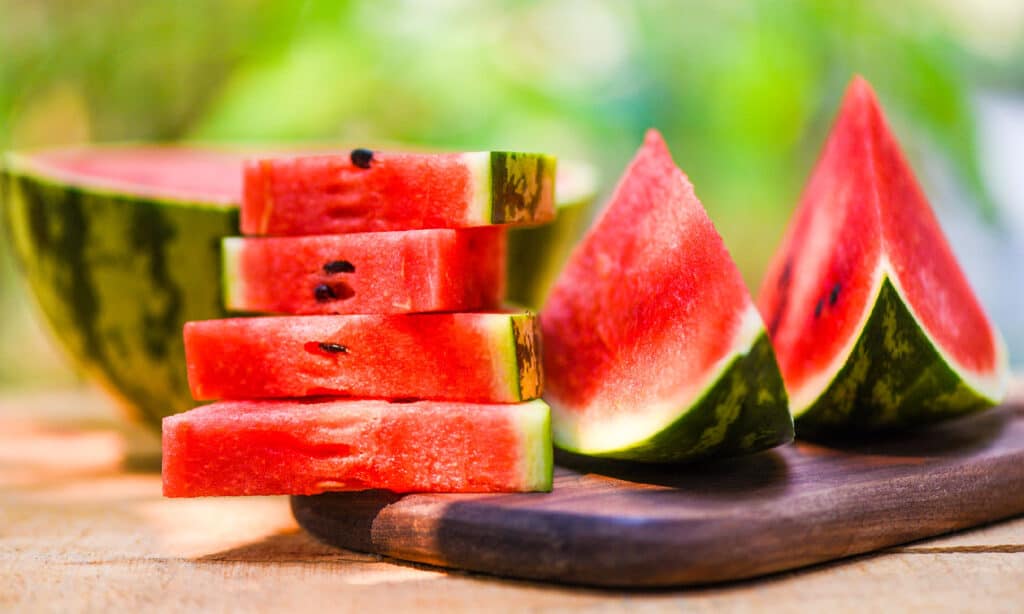
The luscious, juicy flesh of the watermelon is normally deep crimson to pink and includes numerous black seeds, though there are varieties without seeds.
©iStock.com/panida wijitpanya
Another famous red fruit, watermelon grows from a trailing vine-like plant and is one of the healthiest foods in the world. It’s packed with nutrients, lycopene, and antioxidants, which can help fight diseases. Watermelon can range in flavor from bitter to sour and sweet.
4. Cherry
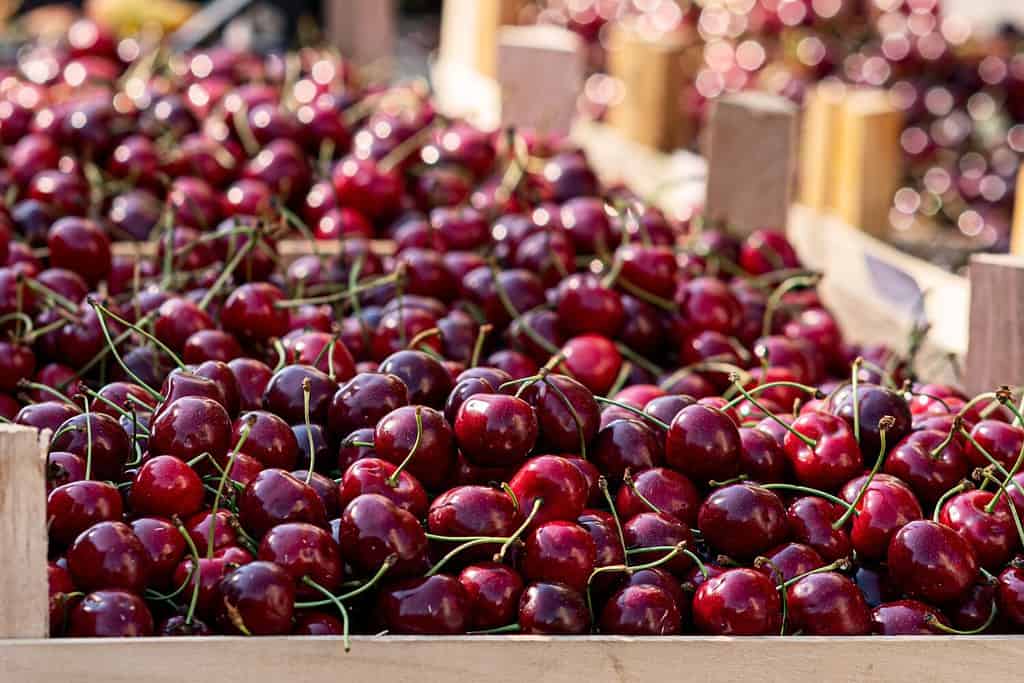
Cherries are the perfect balance of sweet and tart
©Andrey Mihaylov/Shutterstock.com
The cherry has many varieties of red fruit, such as the sweet cherry, bing, and rainier. Cherries, in general, are heart-healthy and can lower cholesterol, blood sugar, and blood pressure. They can even help you sleep better! Cherries are the perfect balance of sweet and tart.
5. Cranberry
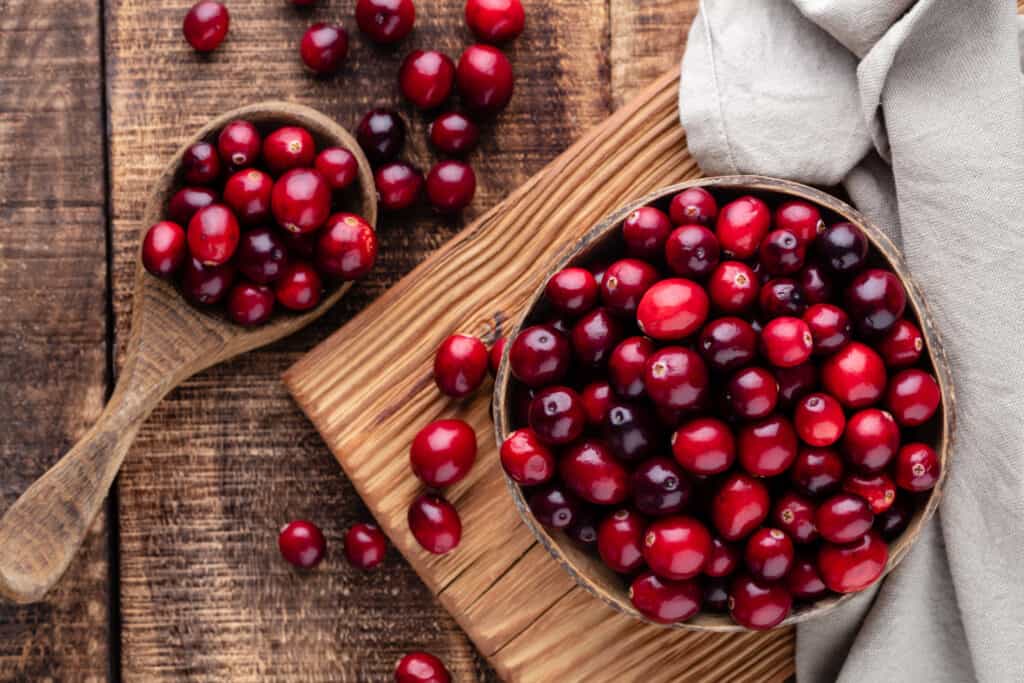
Cranberries are a superfood rich in antioxidants that are great for urinary health
©iStock.com/gitusik
A group of evergreen shrubs or trailing vines, cranberries come in different varieties. But in America, you may recognize them as the red sauce that adorns your Thanksgiving table. This fruit can obviously be eaten any time of the year as it is considered a superfood. Cranberries are rich in nutrients and antioxidants and are great for urinary health.
6. Red Cactus Pear
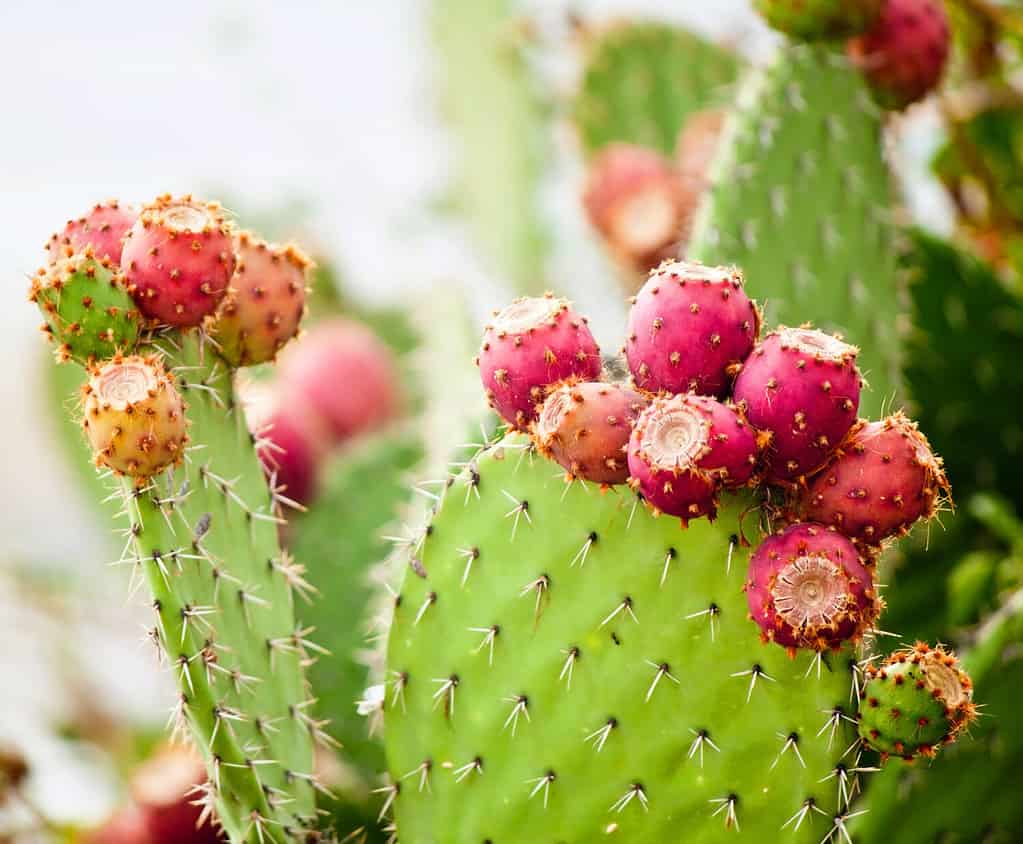
Cactus pear, or prickly pear, is juicy and aromatic and great for treating hangovers
©fischers/Shutterstock.com
The red cactus pear is a small to medium-sized oblong fruit that grows on a species of cactus in the United States and Mexico. Red cactus pears are juicy, aromatic, and sweet. And they can treat diabetes, lower cholesterol, and fight inflammation. They are also great for hangovers!
7. Pomegranate
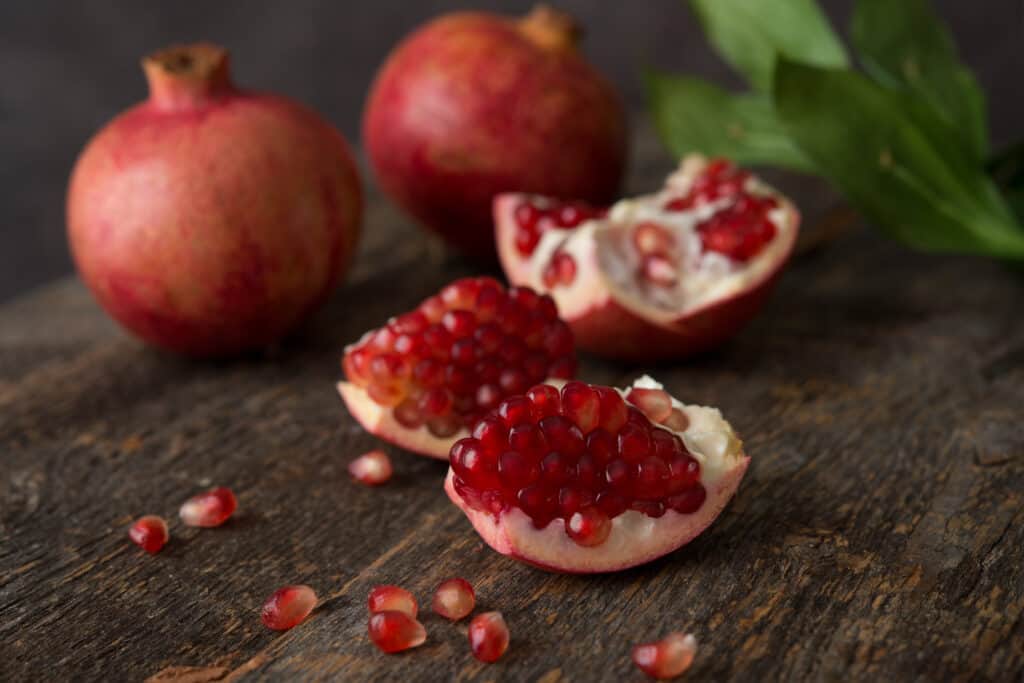
Pomegranates have anti-inflammation and anti-cancer properties
©Gorenkova Evgenija/Shutterstock.com
This fruit-bearing deciduous shrub produces large bright red fruits with dark red seeds inside. They are originally from the Mediterranean region and contain many health benefits, such as anti-inflammation, anti-cancer phytonutrients, digestive support, and urinary health. Pomegranates taste similar to cranberries – very tart and slightly sweet.
8. Blood Orange
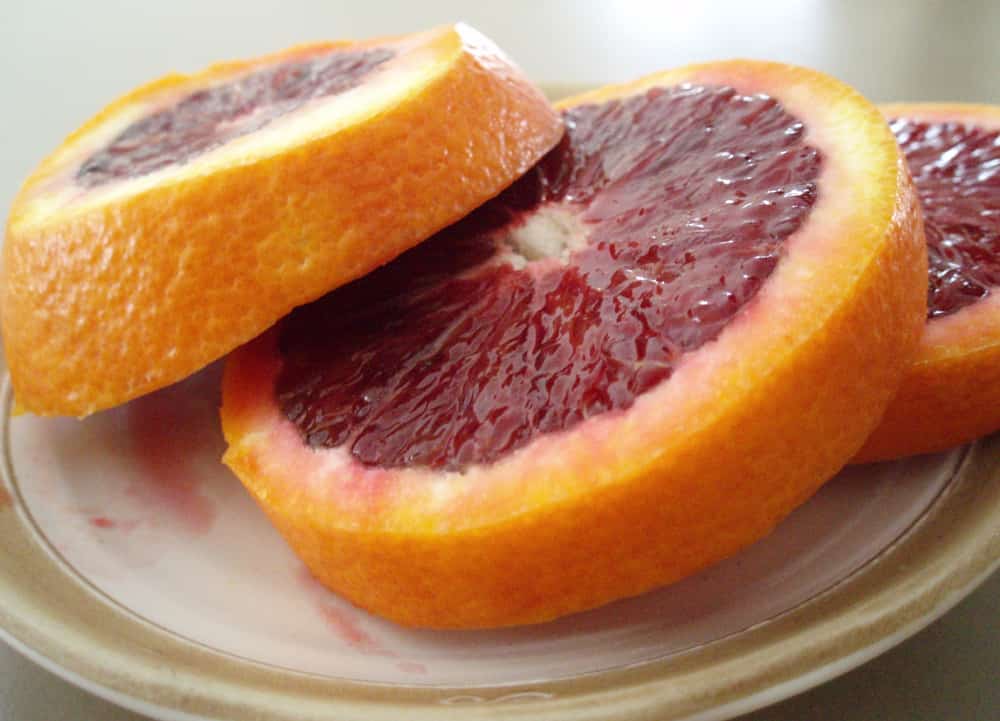
Blood oranges are named for their crimson endocarp. And they have high doses of vitamin C
The blood orange is a variety of regular orange except with a red interior and slightly different taste. Blood oranges are a mix of citrus, sweet orange, and tangy grapefruit. And they have high doses of vitamin C, which is excellent for supporting a healthy immune system.
9. Raspberry
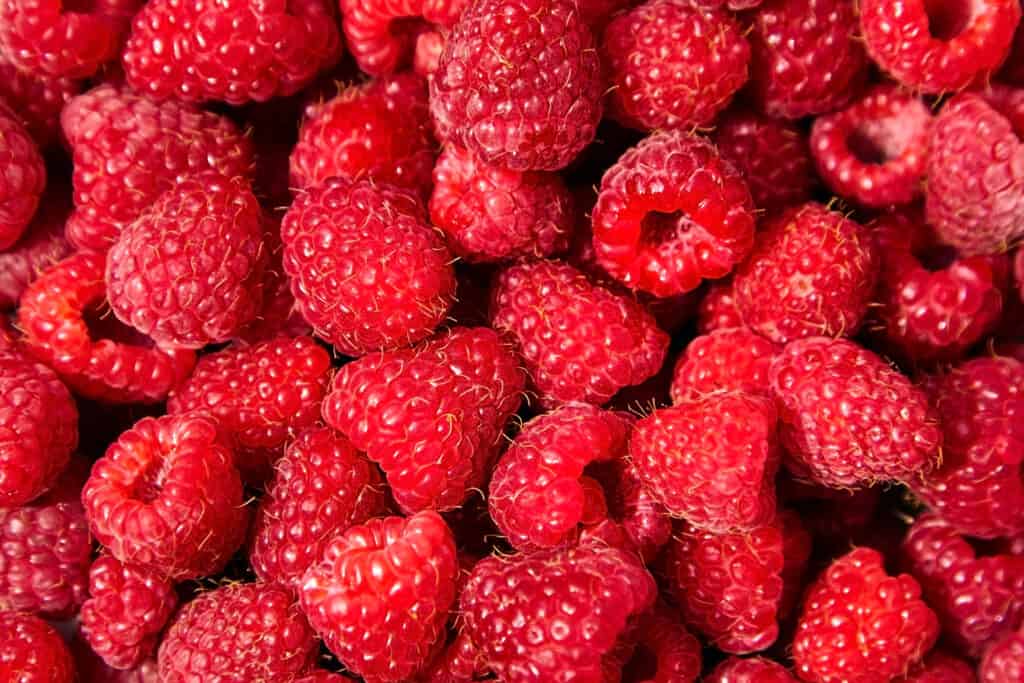
Raspberries are a great source of potassium and omega-3 fatty acids
©Mike_O/Shutterstock.com
An edible fruit from perennial plants with woody stems, raspberries are a favorite fruit across the United States. Raspberries are an excellent source of potassium and omega-3 fatty acids, both of which are excellent for your heart health. This berry is juicy, sweet, tart, and floral.
10. Red Currant

Red currants are great when eaten raw or used to makes jam
©Tim UR/Shutterstock.com
The red currant belongs to the gooseberry family and is native to Western Europe. They are small, round, and red fruits that you can eat raw or in recipes, like jam and ice cream. Red currants taste like a mix of raspberries and rhubarb. This fruit is a good source of fiber and can help improve your digestive health.
11. Cherry Tomato

Growing tomatoes is a very rewarding experience as a gardener. Cherry tomatoes are great for your skin and bones
©Graham Corney/Shutterstock.com
Did you know that tomatoes are actually fruits? Yep! The cherry tomato is a small, round, and red tomato often found in the wild or domestic gardens. Cherry tomatoes are great for your skin, bones, and immune system. And they taste bright and fruity.
12. Red Plum
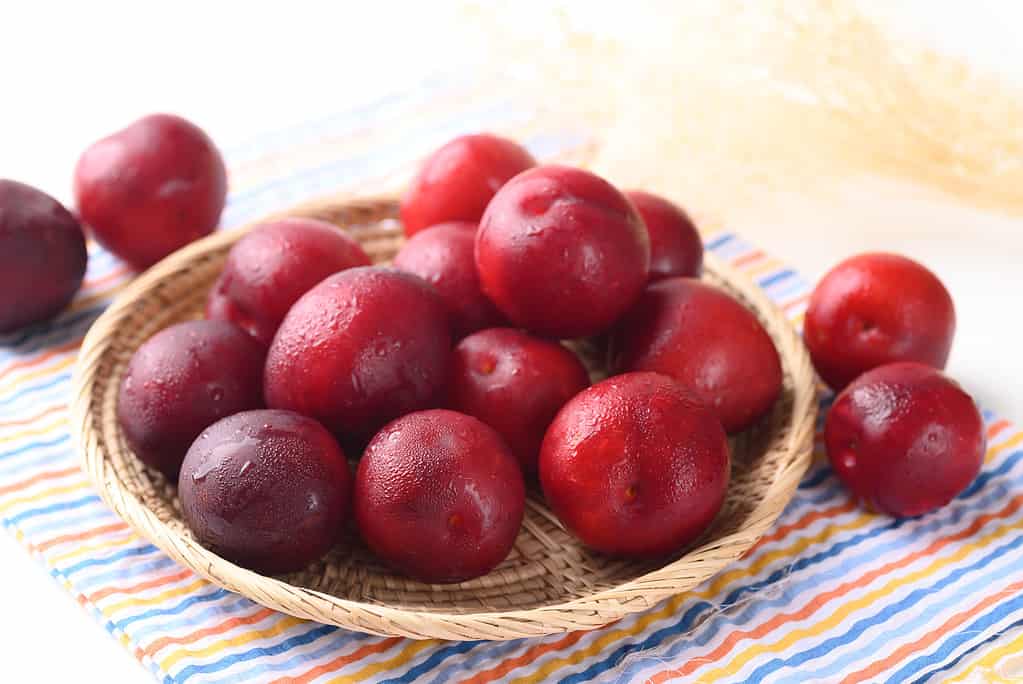
The red plum is sweet, tart, and an excellent source of fiber
©Nungning20/iStock via Getty Images
Red plums have bright red, smooth skin and reddish-orange flesh. They are sweet and tart and an excellent source of fiber, potassium, zinc, and vitamin E. Eat this fruit to help your immune system, digestion, and inflammation. And you can either eat them as a fresh snack or add them to salads and yogurt.
13. Red Goji Berry
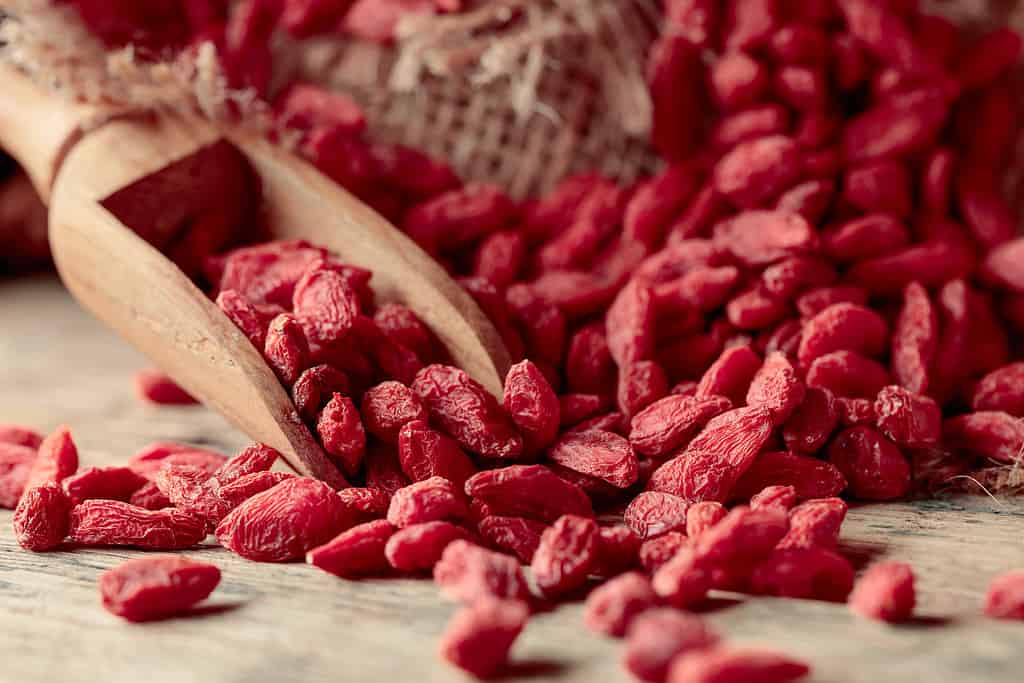
Goji berries taste like a cross between cherries and cranberries
©igorr1/iStock via Getty Images
These tiny red berries are packed full of antioxidants and vitamins that can boost your immune system and fight inflammation and free radicals. These berries are tangy and sweet and taste like a cross between a cherry and a cranberry. While great in moderation, goji berries can cause diarrhea or low blood sugar when eaten in excess.
14. Chili Pepper
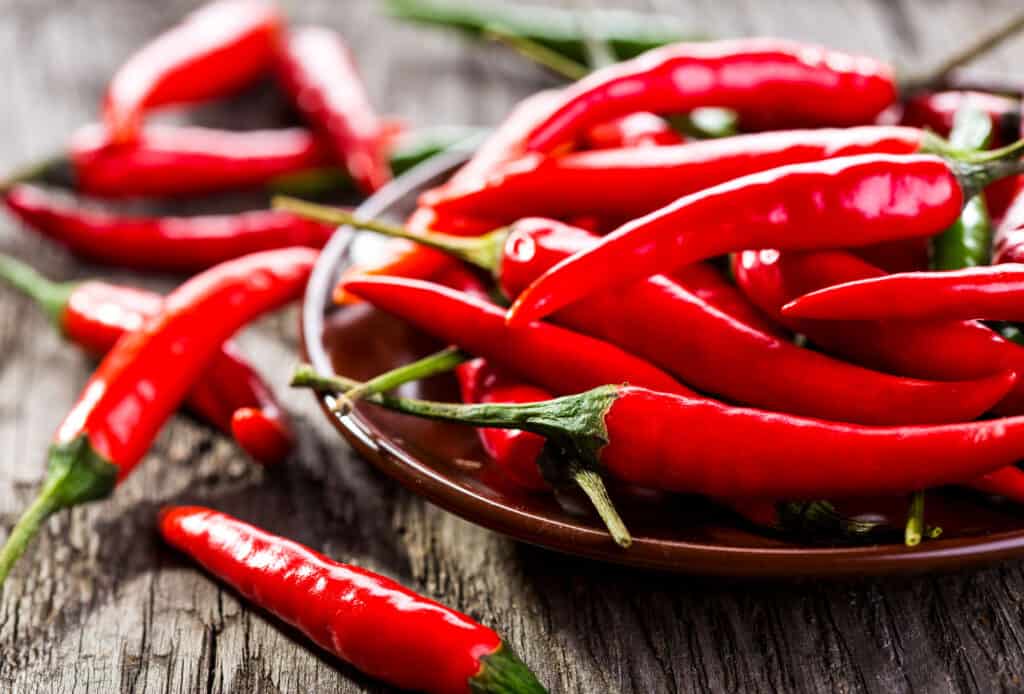
Chili peppers are smoky, spicy, and slightly sweet
©iStock.com/nitrub
While spicy peppers may make you think more of savory vegetable dishes than sweet and fruity, chili peppers are technically fruits, like all peppers. Chili peppers are smoky, spicy, and slightly sweet. And you can use them in many recipes or to make sauces. They are great at reducing inflammation and decreasing the risk of heart disease.
15. Red Anjou Pear

Red anjou pears are juicy, soft, and sweet
©Kateryna Bibro/iStock via Getty Images
The red anjou pear is very similar in shape, size, and taste to green anjou pears. Its red color comes from a spontaneous transformation that makes it deep red. They are high in magnesium, iron, and vitamins K, C, and B6. Red anjou pears are juicy, soft, subtle, and sweet.
16. Red Dragon Fruit
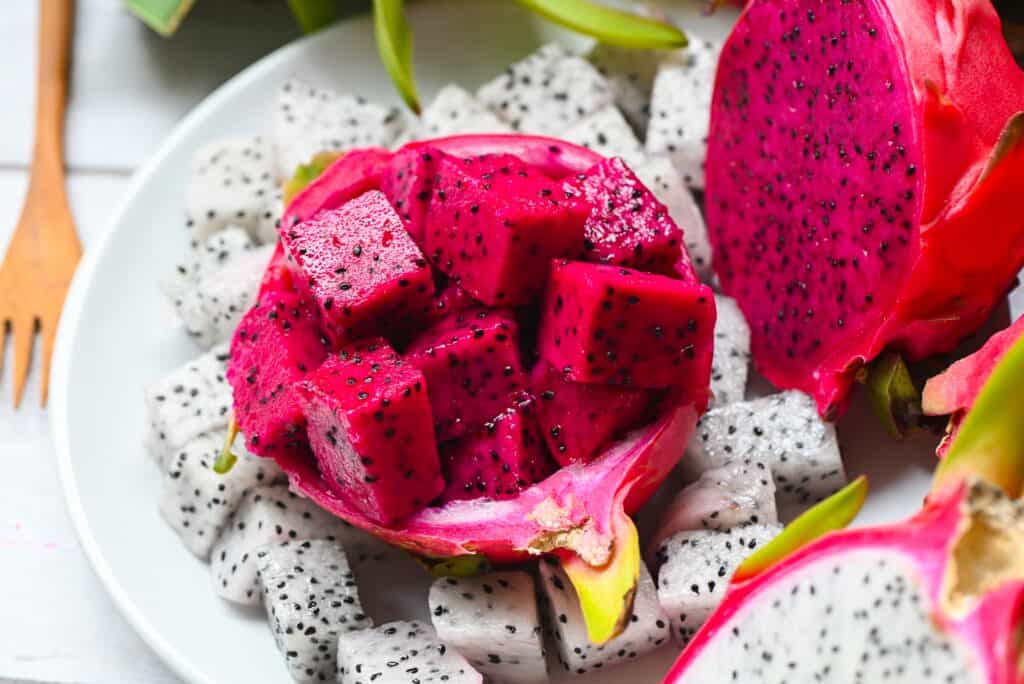
Red dragon fruit helps prevent cancer and protect the body from toxins
©Poring Studio/Shutterstock.com
The red dragon fruit is a variety of regular dragon fruit native to Southern Mexico and parts of Central America. They have bright pink exteriors and deep red interiors. And they have abundant antioxidants that can help prevent cancer and protect the body from toxins. Red dragon fruit is mildly sweet and tastes like a cross between a pear and a kiwi.
17. Desert Quandong

Desert Quandong is an edible fruit native to the deserts of Australia
©mastersky/iStock via Getty Images
A hemiparasitic plant in the sandalwood family, the desert quandong is an edible fruit native to the central and southern deserts of Australia. It has an earthy, fermented odor but tastes sweet and sour with a salty aftertaste. This red fruit is high in vitamin E, folate, calcium, and magnesium.
18. Red Chokeberry
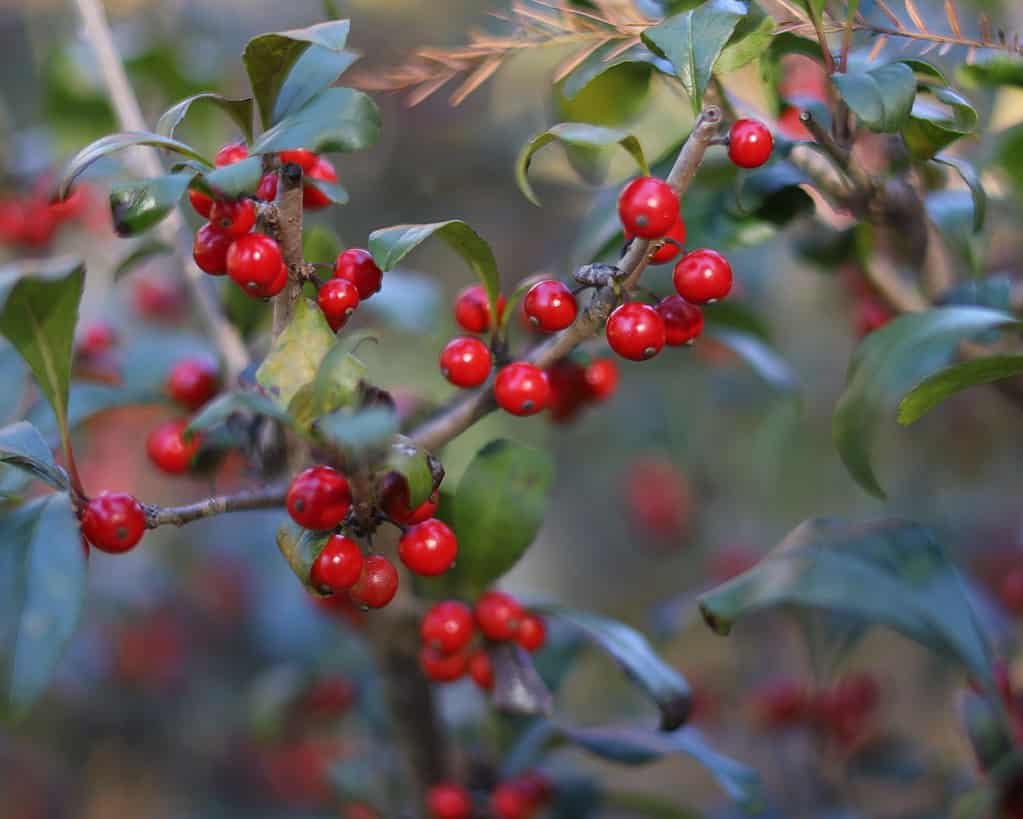
Red chokeberries are often used to make jams and jellies
©Wirestock/iStock via Getty Images
The red chokeberry is a native shrub from the rose family in North America. You can eat red chokeberries raw or use them to make jams and jellies. However, they taste bitter and acidic when eaten raw. But they are a superfood that contains very high amounts of antioxidants.
19. Red Guava
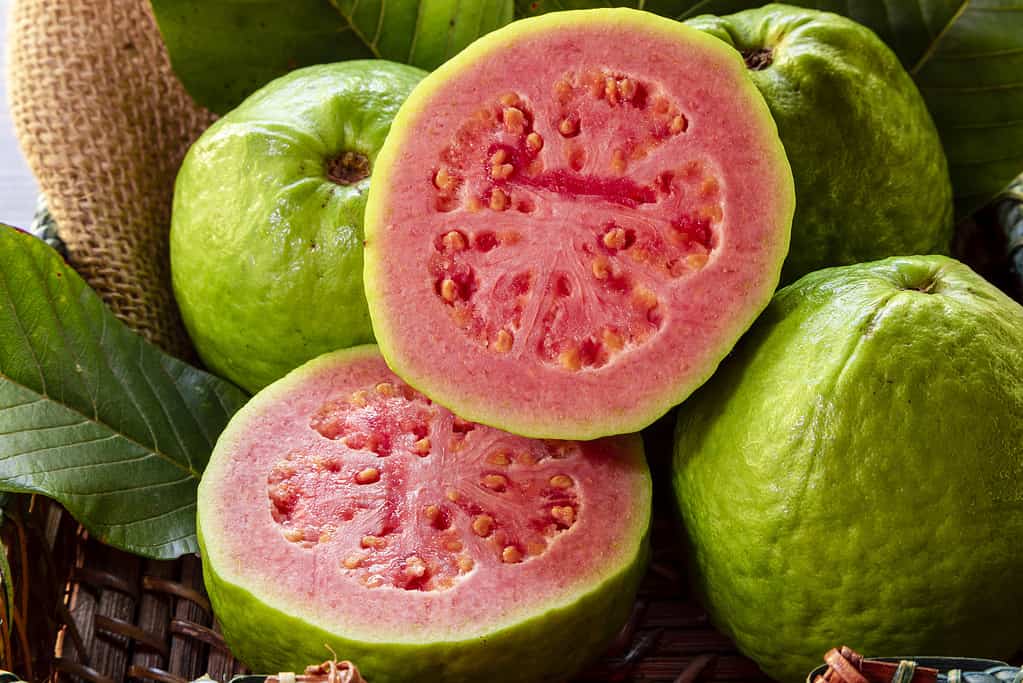
Red guava tastes like a cross between pears and strawberries
©Murilo Gualda/iStock via Getty Images
Native to Mexico, Central America, and the Caribbean, red guava is a rare variety of regular guava. Red guava is very sweet and tastes like a cross between pears and strawberries. They are also high in vitamin C and antioxidants.
20. Five-Flavor Berry
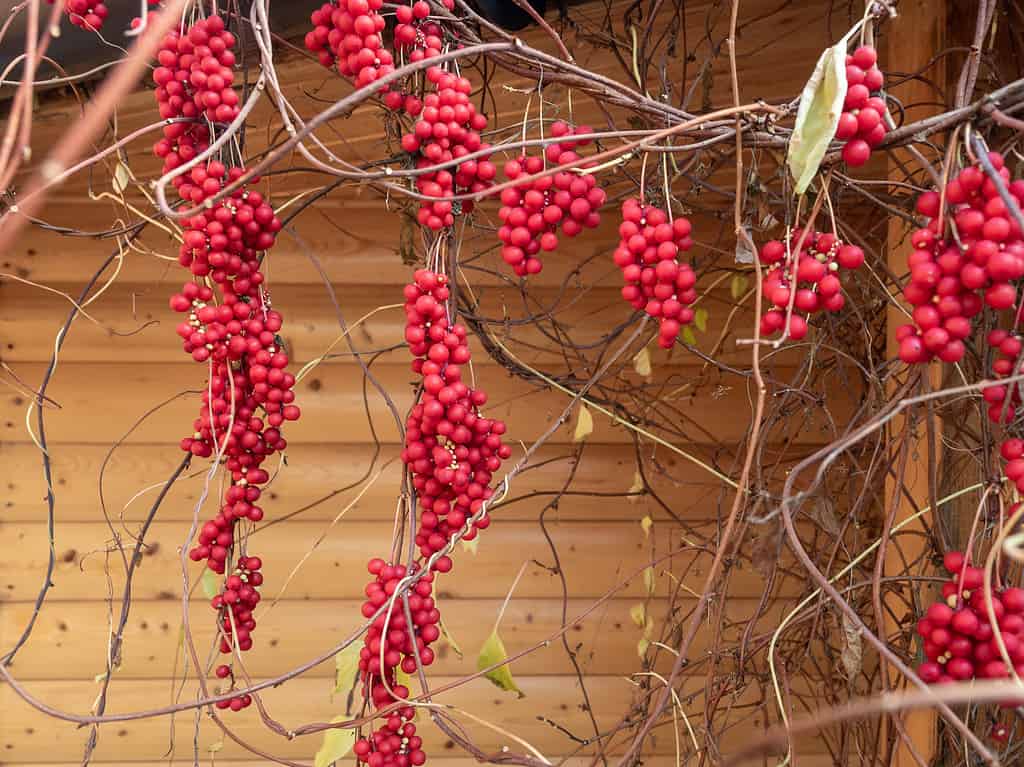
The five-flavor berry is a vine plant native to Asian forests
©Geshas/iStock via Getty Images
Also known as the magnolia berry, the five-flavor berry is a vine plant native to Asian forests. These berries were originally used in traditional Chinese medicine to treat coughs, liver conditions, digestion problems, and fatigue. Five-flavor berries have a unique taste of sweet, sour, bitter, and salty.
21. Red Grapefruit
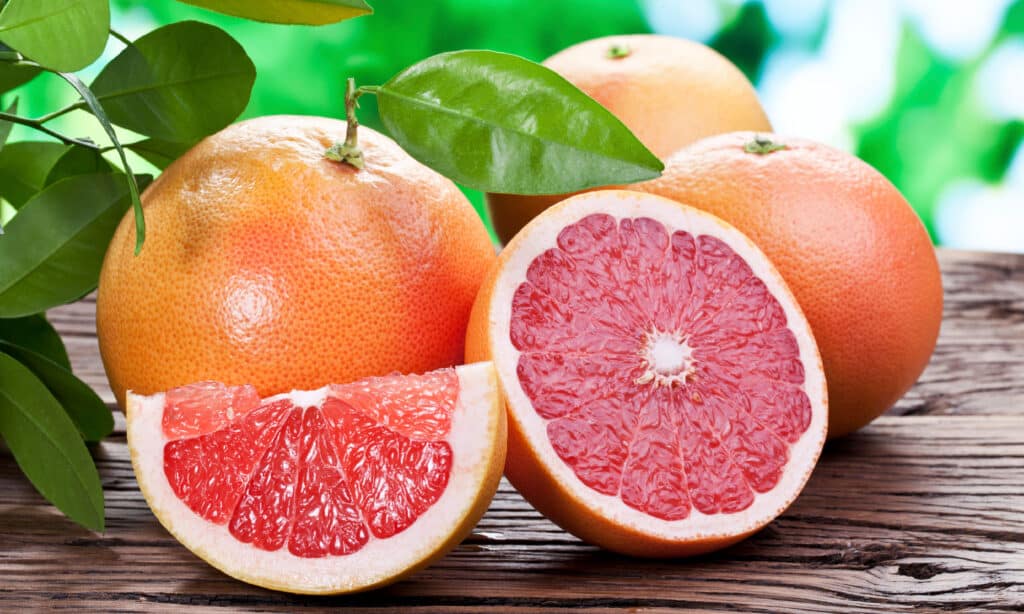
Grapefruit is packed with vitamin C and great for your immune system
©iStock.com/ValentynVolkov
Grapefruits are subtropical citrus fruits with ruby red interiors. Like other citrus fruits, red grapefruits are high in vitamin C, which is great for your immune system and can help you fight off viruses. This fruit is sour, bitter, and somewhat sweet.
22. Red Kiwi
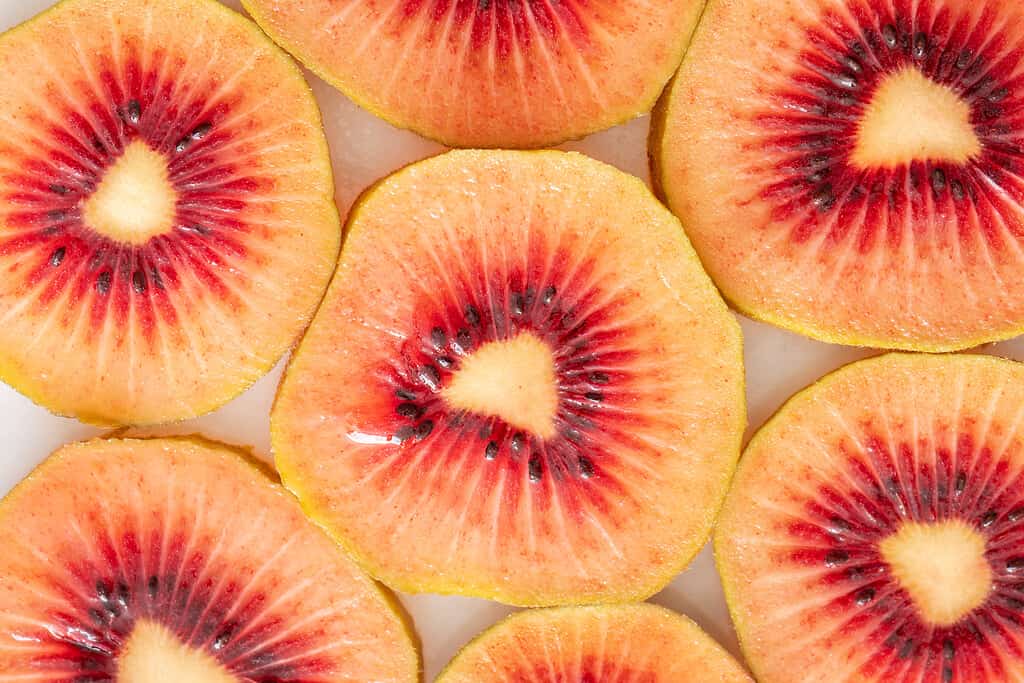
Red kiwi is sweet, tart, and fruity
©agcreations/iStock via Getty Images
This variety of kiwi has a light-colored peel and a golden interior with a red heart at the center of the fruit. You can occasionally find them in grocery stores, and they are very popular due to their perfect blend of sweet and tart with a fruity aroma. Kiwi fruit is high in fiber and vitamin C and is one of the healthiest fruits on the planet.
23. Hala Fruit
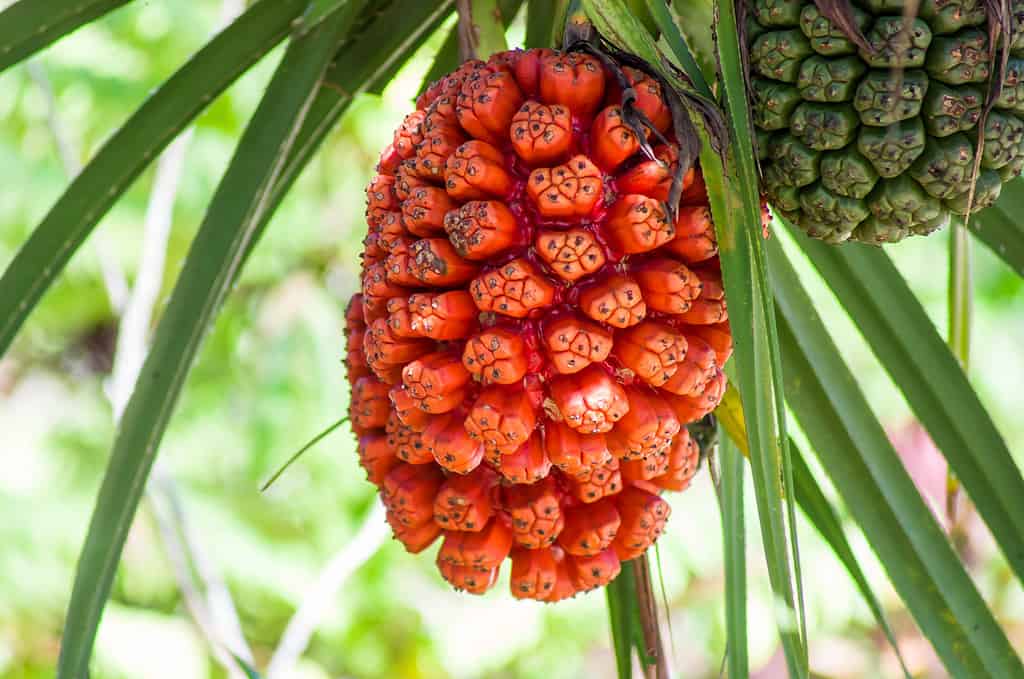
Hala fruit features sweet and tropical bright red cones
©nty/iStock via Getty Images
Native to Australia and the Pacific Islands, hala fruit grows in coastal lowlands near the ocean. They are large and edible, with numerous bright red cones. Hala fruit is mild, sweet, and tropical, with a similar taste to jackfruit or pineapple. It can boost your immune system, promote heart health, improve digestion, and increase bone density.
24. Rambutan
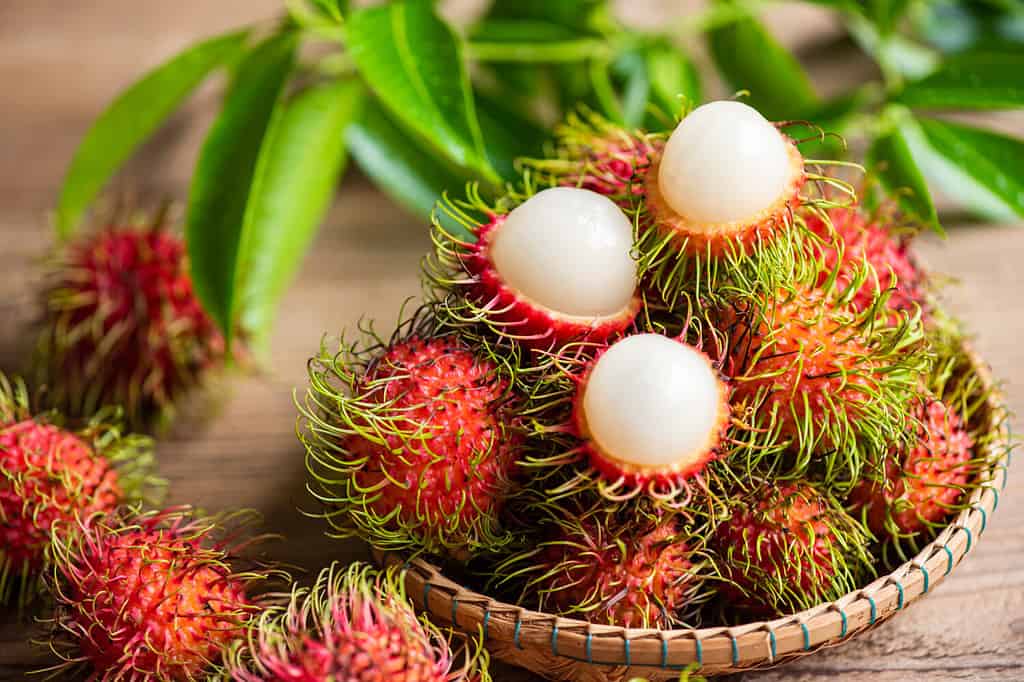
Rambutan tastes great when used in salads or desserts
©Bigc Studio/Shutterstock.com
This unusual fruit comes from a medium-sized tropical tree native to Southeast Asia. Rambutan has a bright red and fuzzy exterior with bright white flesh. It’s teeming with antioxidants and nutrients, and you can eat it in many ways, including adding it to salads or desserts. Rambutans are sweet, fruity, and slightly acidic.
25. Highbush Cranberry
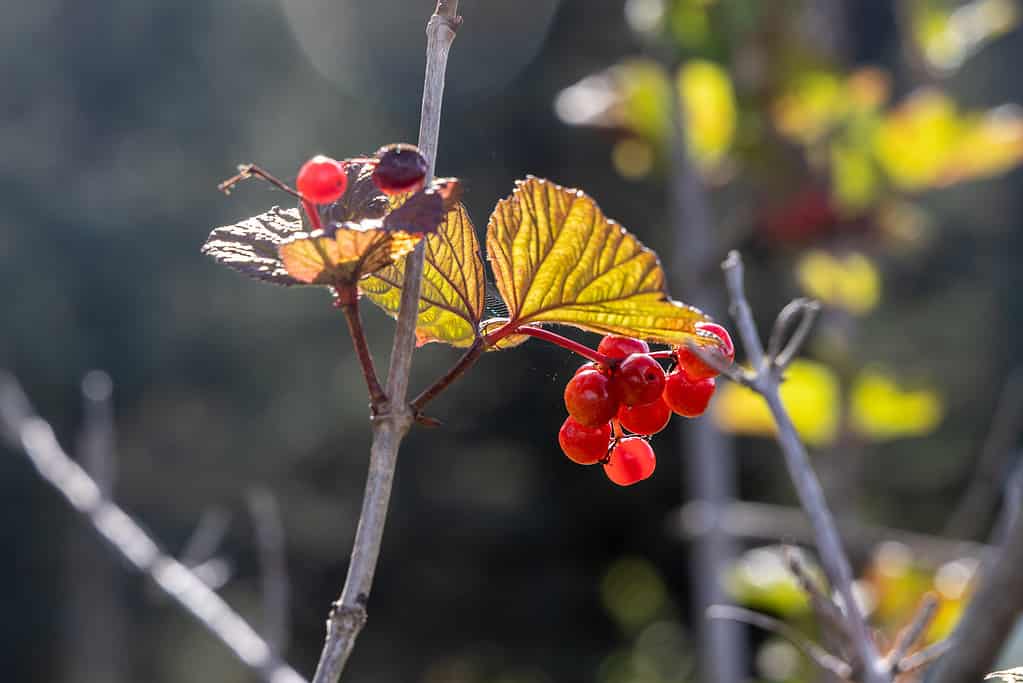
Highbush cranberries are native to North America and taste tart and acidic
©Sherry Smith/iStock via Getty Images
Despite its name, the highbush cranberry is not a cranberry. It is a species of drupe native to northern North America. You can eat these berries raw or cooked or boil their leaves to make tea. They are rich in vitamin C and taste tart and acidic.
26. Red Durian

peeled red color durian native to the jungle of Borneo.
©lanolan/iStock via Getty Images
The red-fleshed durian is a tree species that produces a large, spiny fruit that, when ripe, has a pungent odor akin to garbage. Despite its smelliness, red durian is sweet, fruity, and slightly bitter. Durian is excellent for digestion, heart health, and controlling blood pressure.
27. Java Apple (Wax Apple)

Java apples are mild and watery, similar to an Asian pear
©800 × 600 pixels, file size: 81 KB, MIME type: image/jpeg – Original / License
This evergreen tree produces edible red pear-shaped fruits with a waxy appearance. They are native to the Malay Peninsula and nearby islands but are also cultivated in the tropics. Java apples do not taste like apples. Instead, their flavor is mild and watery, similar to an Asian pear. Java apples have high amounts of Vitamin C and A, which can help fight against certain cancers.
28. Red Grape
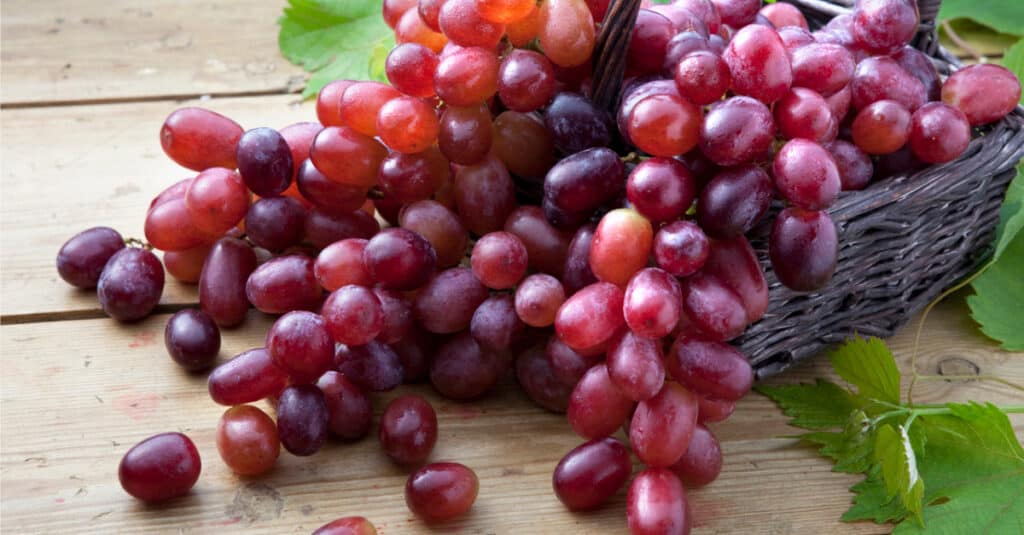
Red grapes come in many varieties and are typically some of the sweetest grapes available
©iStock.com/darrenplatts123
There are at least 20 varieties of red grapes, including red globe, moon drop, and concord. And there are specific red wine grapes, like Cabernet Sauvignon and Merlot. Red grapes are super sweet and have abundant minerals and vitamins, such as potassium, manganese, and vitamins B, C, and K.
29. Jujube Fruit
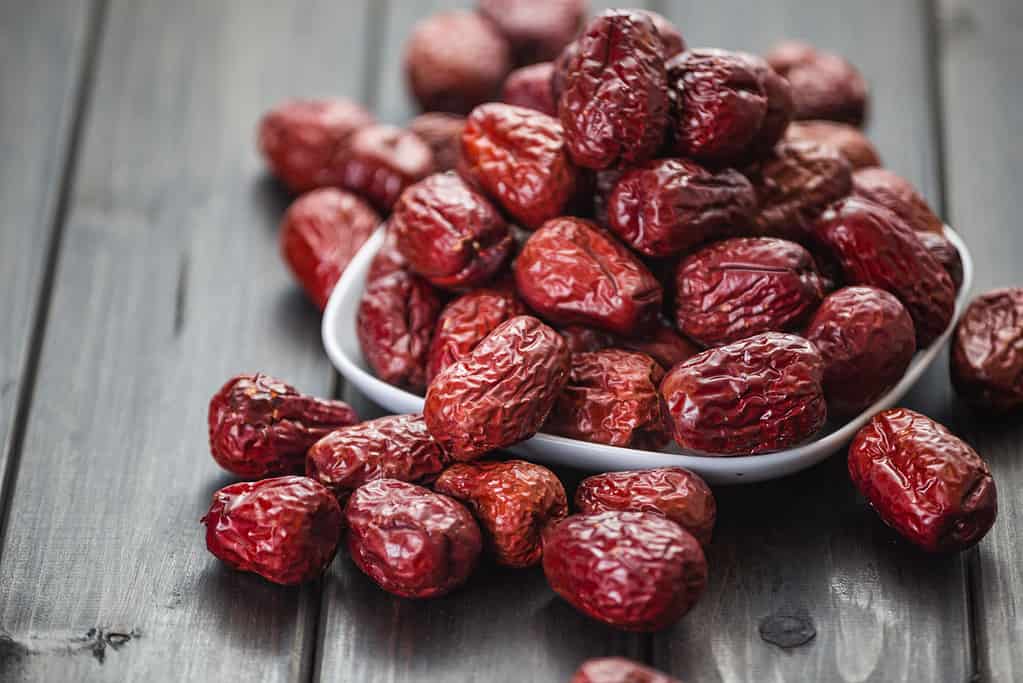
Chinese dates, or jujube fruit, are rich in fiber and low in calories
©Wentao Li/iStock via Getty Images
The jujube fruit, also known as the Chinese date, is a small red fruit grown on large flowering shrubs in Southern Asia. They are low in calories, rich in fiber, and contain minerals that improve bone health and prevent disease. Fresh jujubes taste similar to apples, and dried jujubes taste like dates.
30. Red Passion Fruit
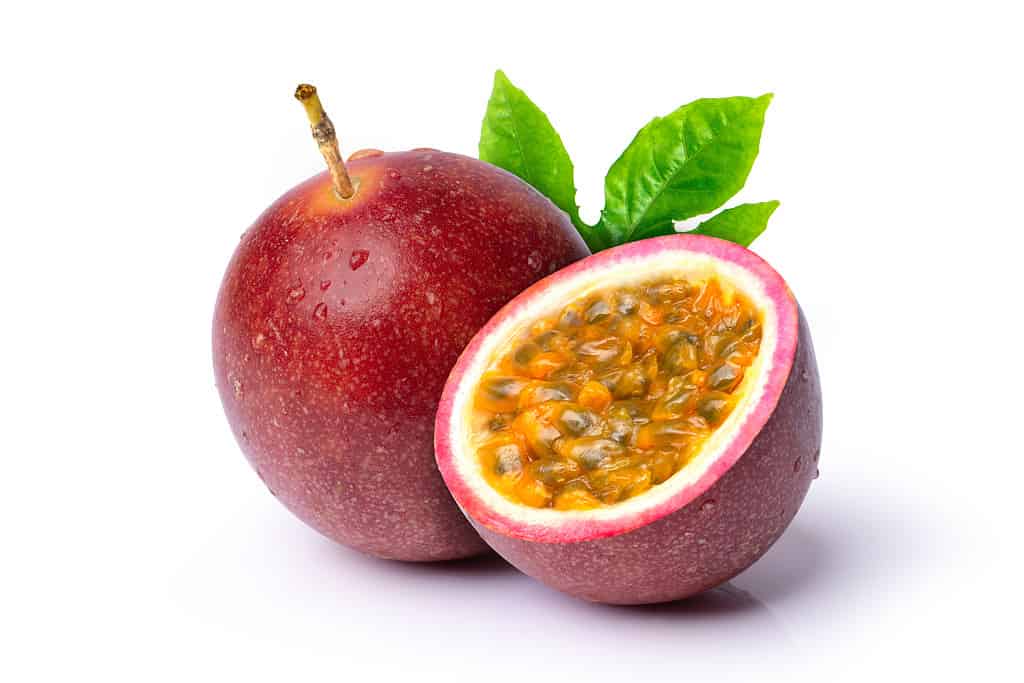
Red passion fruit can be eaten raw or used in jams, marinades, and salsas
©Everyday better to do everything you love/iStock via Getty Images
This vigorous-growing plant produces large, round fruits with red exteriors and brown-yellow flesh. You can eat red passion fruit raw or use it in recipes like jams, cakes, marinades, and salsas. This fruit is floral and citrusy with a blend of sweet and sour. It has high levels of vitamins A and C, which can benefit your skin, vision, and immune system.
31. Nectarine
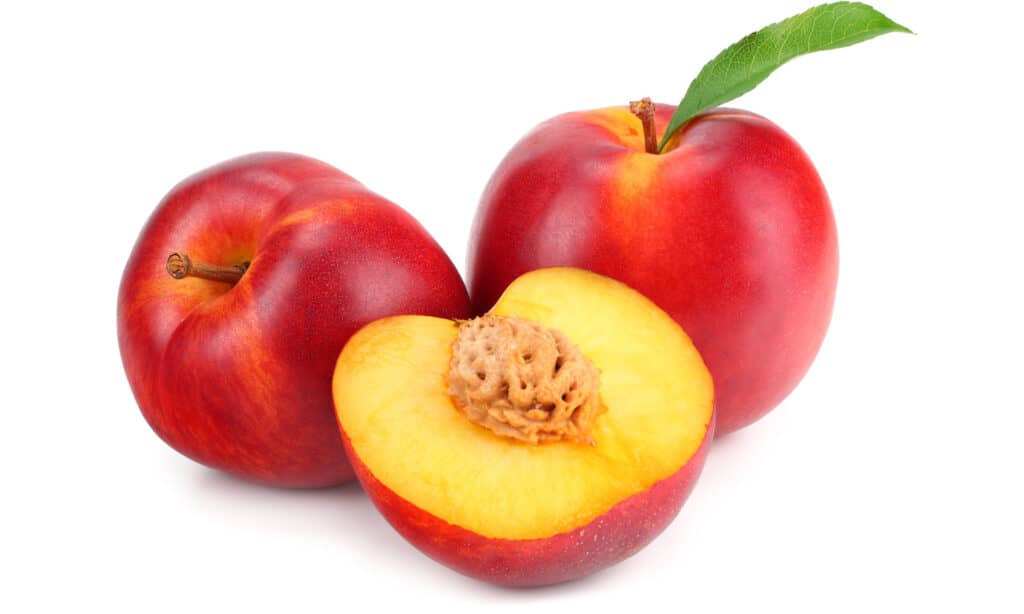
Nectarines are slightly sweeter and smaller than peaches
©iStock.com/Dmytro
The nectarine is a stone fruit very similar to a peach. Nectarines are slightly smaller than peaches, and they taste somewhat sweeter. They are juicy, sweet, and acidic. Nectarines are excellent when eaten raw or used in recipes. And they are high in fiber, vitamins, and minerals that boost immunity, lower blood pressure, and promote longevity.
32. Red Tamarillo
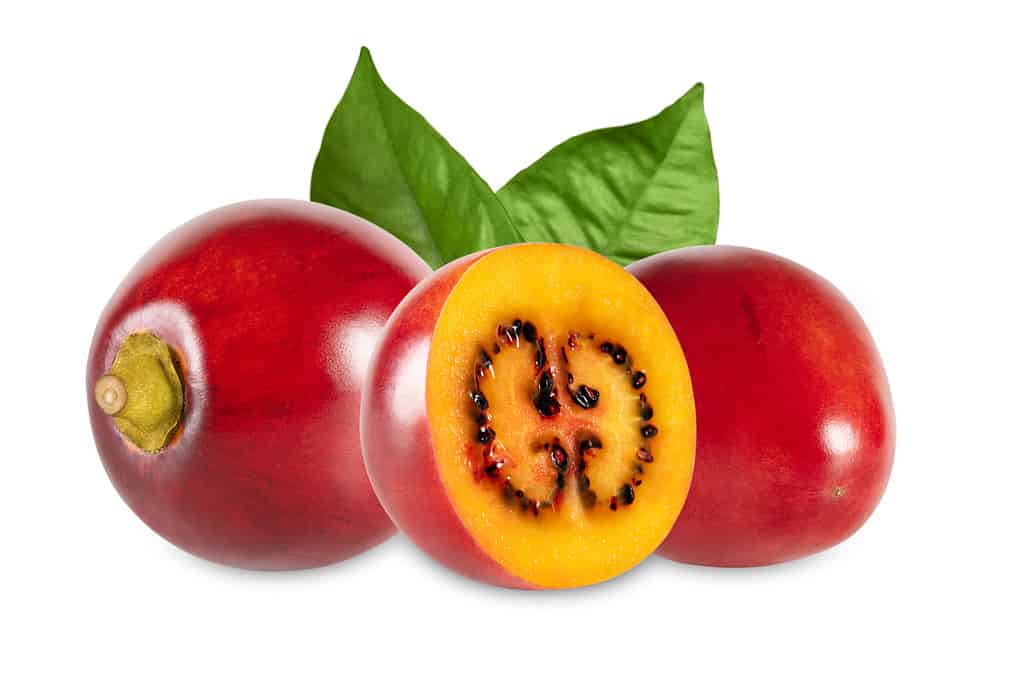
Tamarillo is native to Central America and has a bitter, tangy, and slightly sweet flavor
©Marina Bagrova/iStock via Getty Images
Small, oval, and bright red, the red tamarillo is a fruit produced from a small flowering tree native to Central America. This fruit is similar in appearance to a tomato but has a bitter, tangy, and slightly sweet flavor. Tamarillos are low in calories, high in fiber, and contain vitamins and antioxidants.
33. Pluot
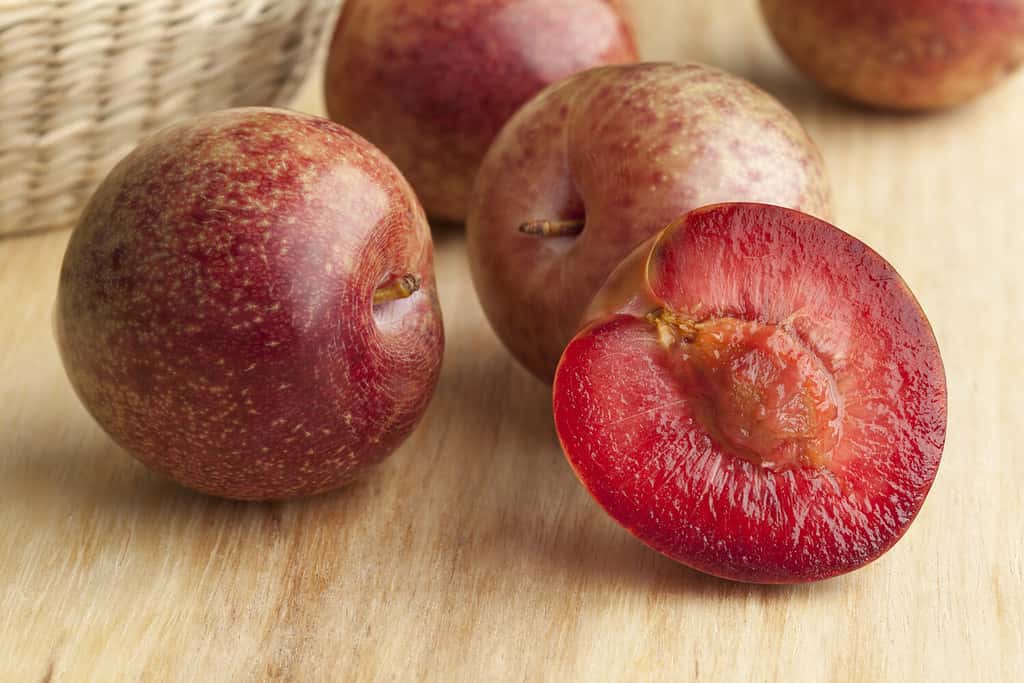
The pluot is a cross between an apricot and a plum
©Picture Partners/Shutterstock.com
Pluots are hybrid fruits between apricots and plums. They are small, round, and bright red. And they are pleasantly sweet with a flavor that more closely resembles a plum. But its skin is not bitter and more like an apricot. Pluots are high in sugar, but they have lots of fiber, potassium, and vitamin C.
34. Red Banana
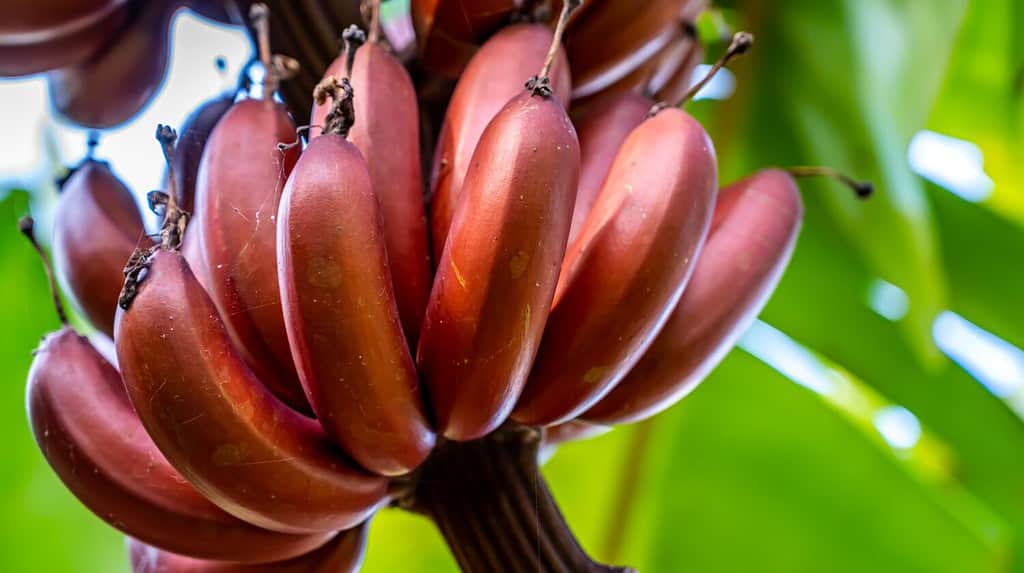
Red bananas are native to Southeast Asia
©PrivinSathy/Shutterstock.com
While you may only be familiar with the bright yellow fruit, red bananas are a reddish-purple variety with a cream to light pink flesh. This banana subgroup is native to Southeast Asia, and they are soft, sweet, and have a hint of raspberry flavor when ripe. Red bananas are rich in calcium and potassium, which is great for bone health.
35. Chinese Bayberry
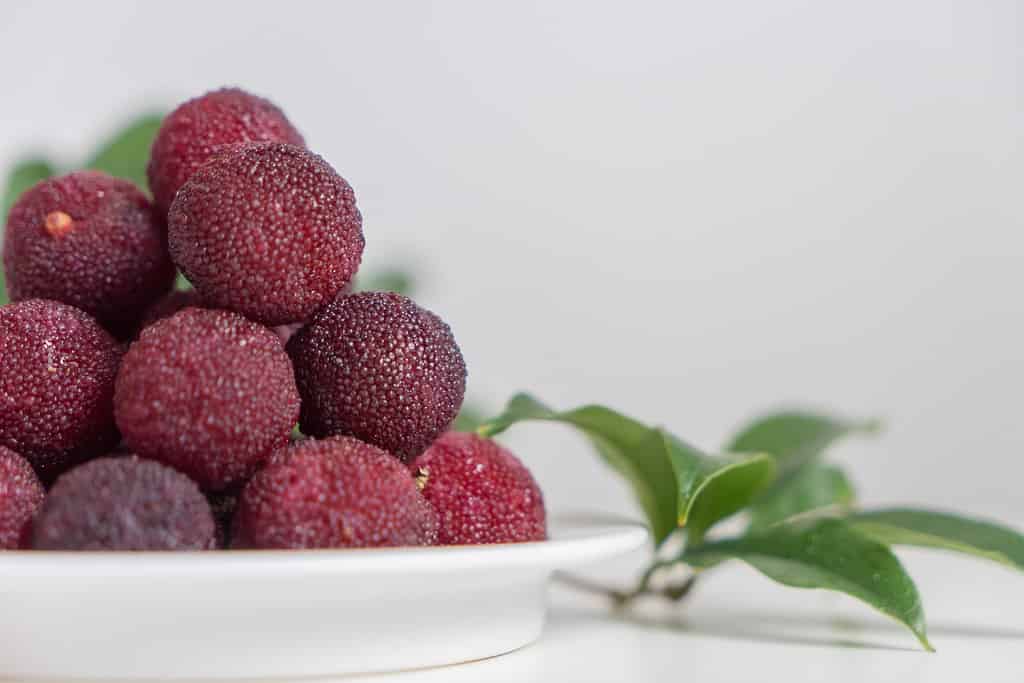
Chinese bayberries taste like a super tart raspberry
©hallojulie/iStock via Getty Images
The Chinese bayberry is a subtropical tree from China that produces good-sized bright red berries with a strange texture. Most people eat them fresh or preserve them by canning or drying them. Bayberries taste similar to raspberries or strawberries but more tart and with an herbal taste.
36. Lychee
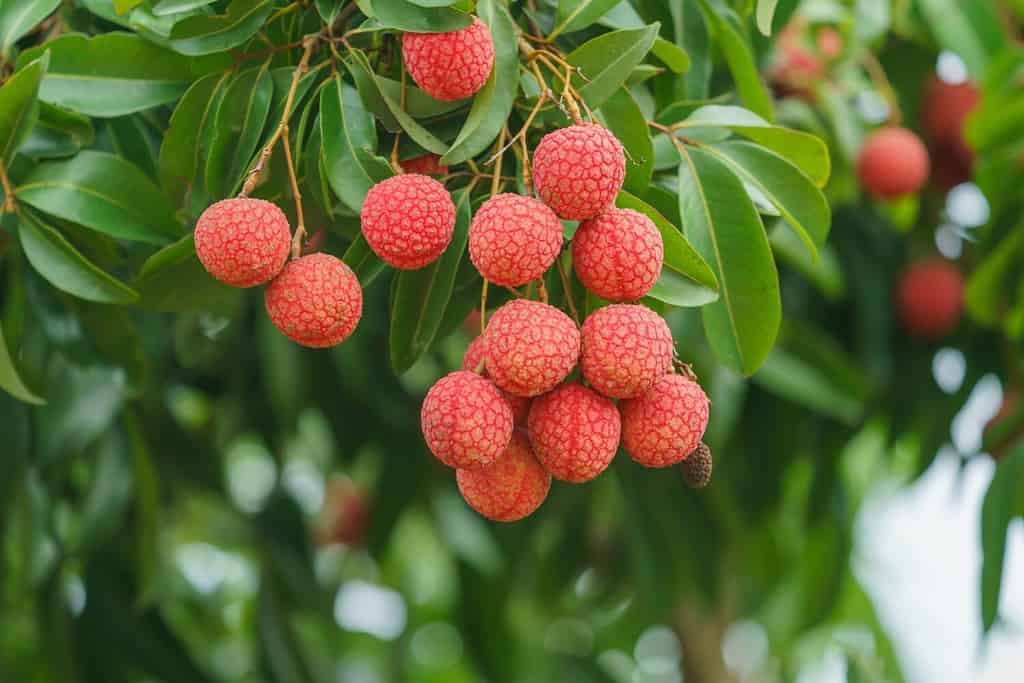
Lychee is great in salads, sauces, desserts, and beverages
©Vietnam Stock Images/Shutterstock.com
The lychee is another unusual-looking fruit from Asia. It has a bumpy and red exterior and a creamy white flesh with a red gel in the center. You can eat this fruit on its own or use it to make salads, sauces, desserts, and beverages. Lychee is a cross between strawberry and watermelon with slightly floral and acidic notes. It is rich in iron, copper, manganese, magnesium, and phosphorus.
37. Red Bell Pepper
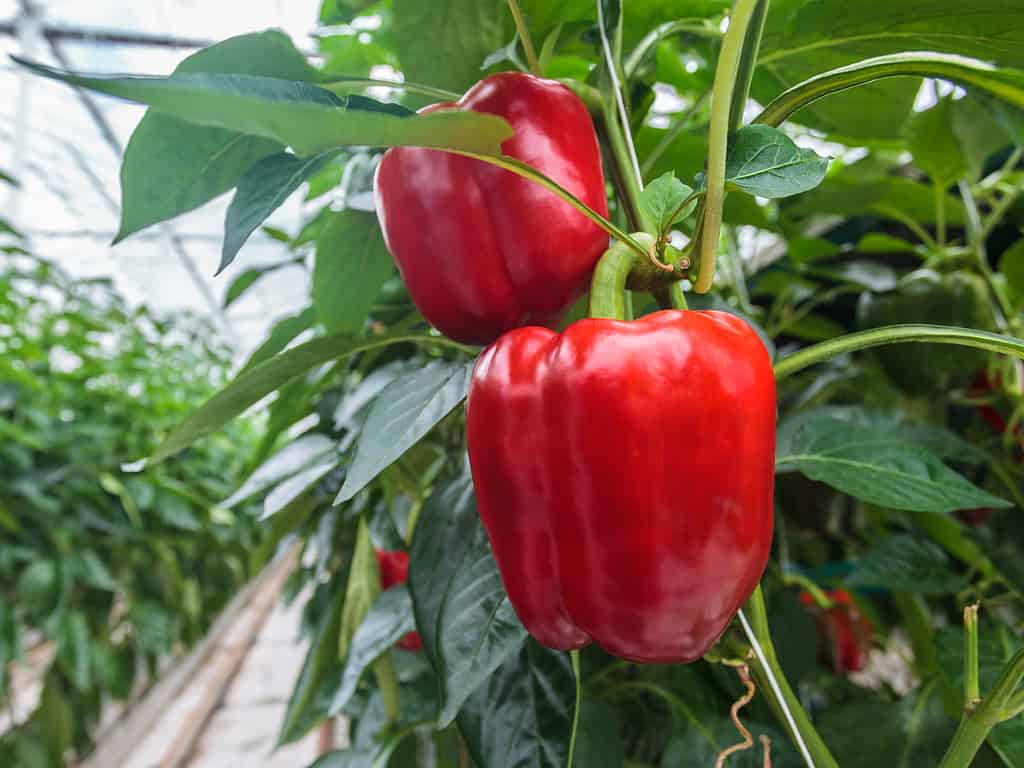
The red bell pepper is sweeter than green bell peppers
©iStock.com/DutchScenery
Red bell peppers are just ripened green bell peppers. This ripened version is much sweeter and great for raw snacking or use in many recipes. Red bell peppers are an excellent source of vitamin C, vitamin A, and fiber. They help protect against some cancers and cardiovascular disease.
38. Mango
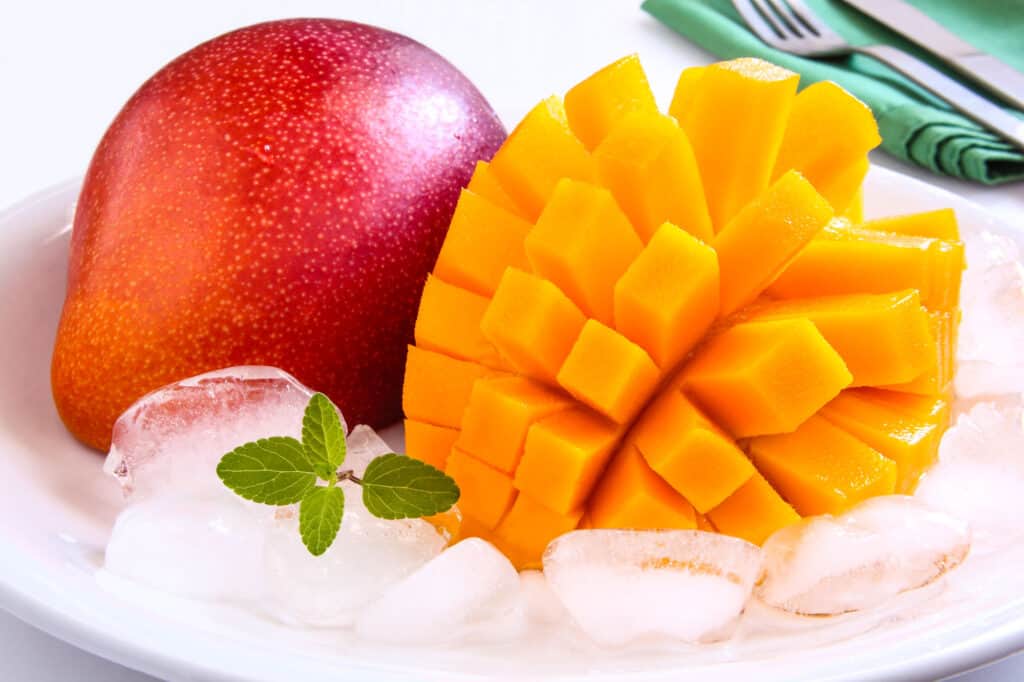
Mango ranges in color from bright red to yellow and green
©hungryworks/Shutterstock.com
Mangoes can vary in color, from green to yellow and bright red, changing as they ripen. These stone fruits originated in Southern Asia but are widely available across the globe. Mangoes are an excellent source of beta-carotene, which fights free radicals and can help prevent cancer. They are sweet and juicy and taste like a combination of many fruits, like pineapples, peaches, bananas, and apricots.
39. Red Mulberry
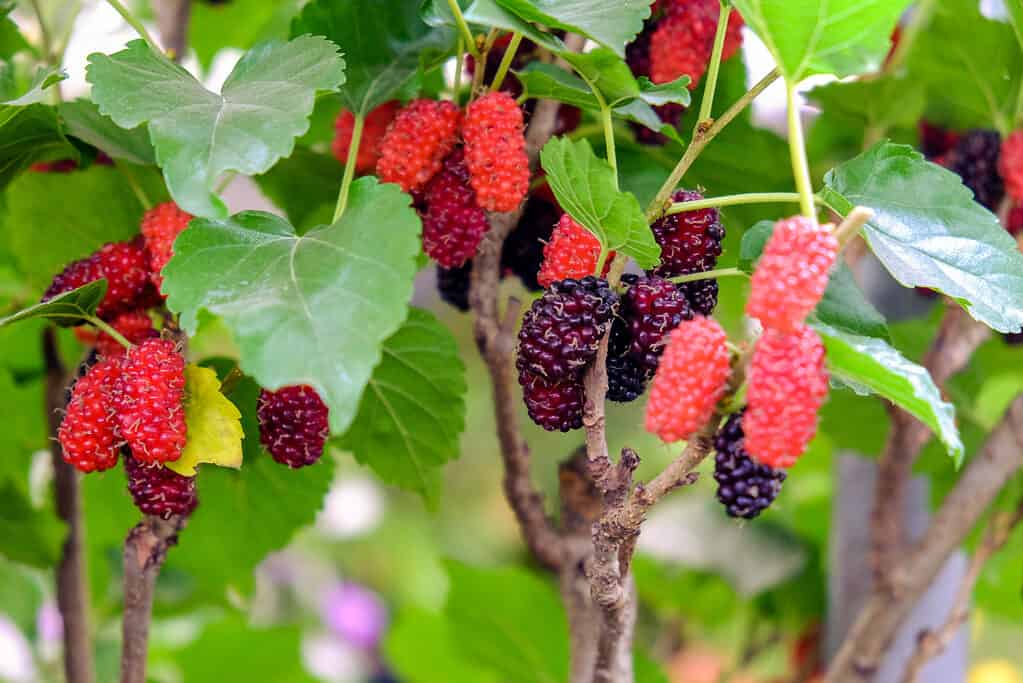
Red mulberry trees grow delicious edible red and purple fruit.
©Aunyaluck/Shutterstock.com
Red mulberries are wild berries native to North America. People eat them raw or use them to make jams, preserves, and pies. And they are refreshing, slightly tart, and sweet. They have several plant compounds linked to lower blood sugar and cholesterol. Plus, they are a good source of iron and vitamin C.
40. Tomato

Tomatoes are sweet and acidic and high in lycopene
©Kamila Koziol/Shutterstock.com
Technically, the tomato is an edible berry grown from the tomato plant. These fruits are native to Mexico, Central America, and South America. They come in many red varieties, from Roma to beefsteak. Tomatoes have a good balance of sweetness and acidity. And they are high in lycopene, which can improve heart health and prevent cancer.
A Recap of the 40 Red Fruits
| #1 | Red Apple |
| #2 | Strawberry |
| #3 | Watermelon |
| #4 | Cherry |
| #5 | Cranberry |
| #6 | Red Cactus Pear |
| #7 | Pomegranate |
| #8 | Blood Orange |
| #9 | Raspberry |
| #10 | Red Currant |
| #11 | Cherry Tomato |
| #12 | Red Plum |
| #13 | Red Goji Berry |
| #14 | Chilli Pepper |
| #15 | Red Pear |
| #16 | Red Dragon Fruit |
| #17 | Desert Quandong |
| #18 | Red Chokeberry |
| #19 | Red Guava |
| #20 | Five-Flavor Berry |
| #21 | Red Grapefruit |
| #22 | Red Kiwi |
| #23 | Hala Fruit |
| #24 | Rambutan |
| #25 | Highbush Cranberry |
| #26 | Red Durian |
| #27 | Java Apple |
| #28 | Red Grape |
| #29 | Jujube Fruit |
| #30 | Red Passion Fruit |
| #31 | Nectarine |
| #32 | Red Tamarillo |
| #33 | Pluot |
| #34 | Red Banana |
| #35 | Chinese Bayberry |
| #36 | Lychee |
| #37 | Red Bell Pepper |
| #38 | Mango |
| #39 | Red Mulberry |
| #40 | Tomato |
Thank you for reading! Have some feedback for us? Contact the AZ Animals editorial team.








